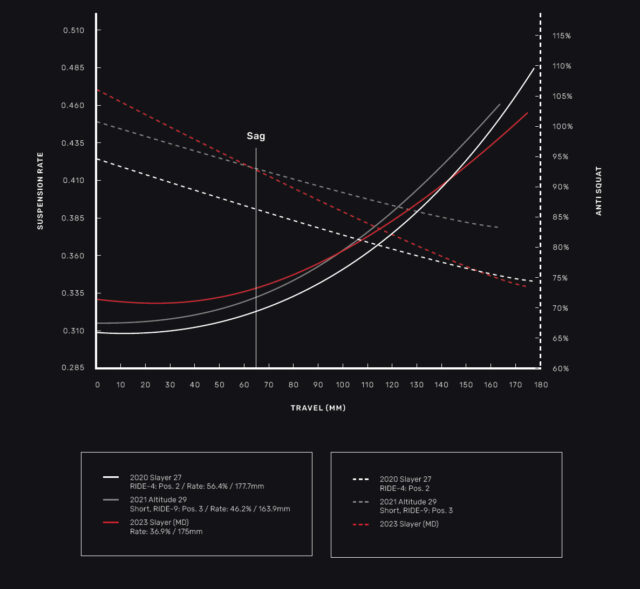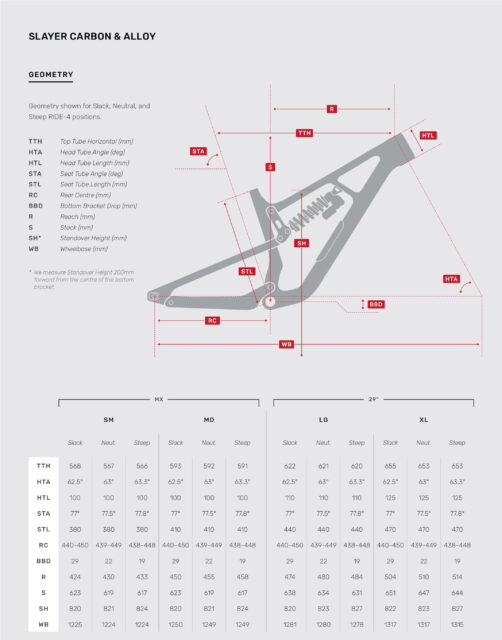2023 Rocky Mountain Slayer
Wheel Size:
- 29’’ front / 27.5’’ rear (size SM and MD)
- 29’’ (LG and XL)
Travel: 180 mm rear / 180 mm front (also compatible with 200 mm travel dual-crown forks)
Geometry Highlights:
- Sizes offered: Small, Medium, Large, XL
- Headtube angle: 63° (Neutral geometry setting)
- Seat tube angle: 77.5° (Neutral geometry setting)
- Reach: 480 mm (Size Large)
- Chainstay length: 439 / 449 mm (Adjustable)
Frame Material: Aluminum and carbon fiber versions available
Price:
- Carbon frame w/ Fox DHX2 Factory: $4,199 USD / $5,499 CAD
- Complete bikes $3,799 to $10,299 USD / $4,699 to $12,999 CAD
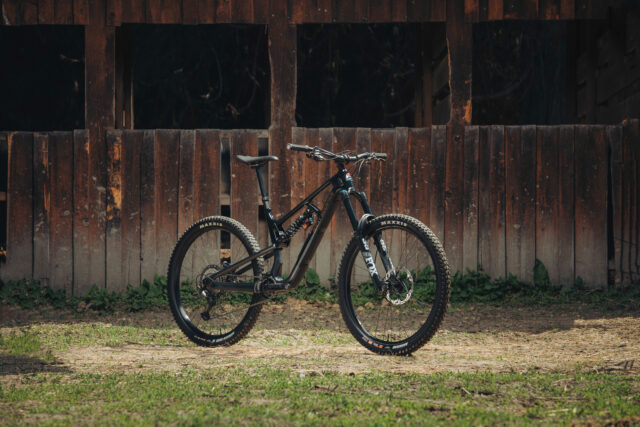
Intro
The first Rocky Mountain Slayer came out in 2001 and featured 26’’ wheels, a whopping 120 mm of rear-wheel travel (with the longer-travel link option), and a frankly hilarious 70.5° headtube angle. Things have changed a little bit since then, but despite massive changes to the geometry, suspension travel, wheel size, and just about everything else, the new eighth-generation Slayer is still being marketed as a Freeride bike.
Rocky Mountain notes (correctly, in our view) that DH bikes are becoming increasingly race-focused and game-on, opening up a window for bikes like the Slayer, the new Devinci Chainsaw, and others. I.e., long-travel bikes meant to serve as more playful park bikes or just big-mountain bruisers that can still be pedaled to the top, filling the gap between true DH bikes and 160–170 mm-travel Enduro ones.
So that brings us to the new Slayer — a 180mm-travel bike with either mixed or full 29’’ wheels, a wheelbase that’s probably about double that of the original (only exaggerating a little bit), and an all-new frame with a bunch of tweaks and refinements from the prior-gen Slayer.
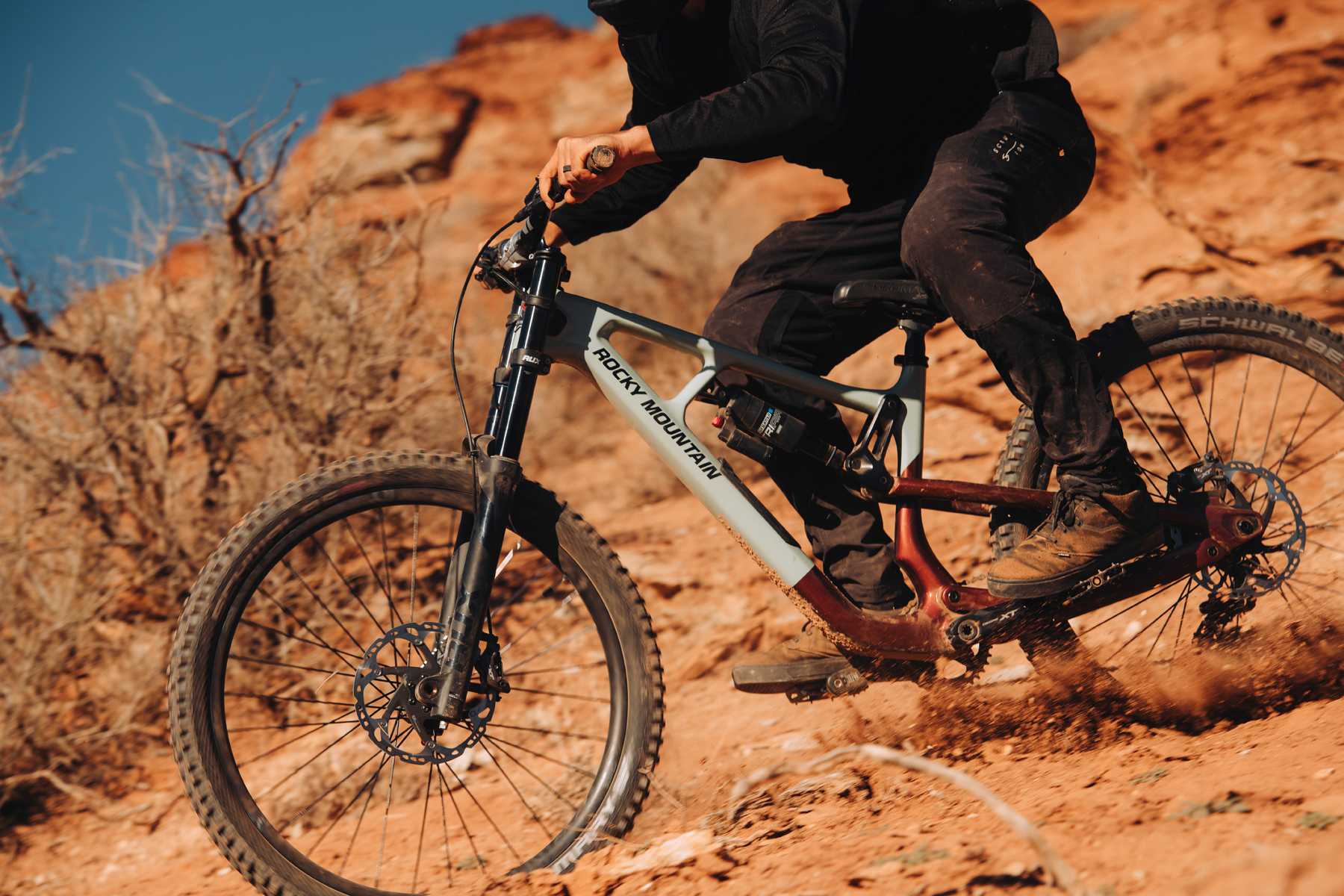
The Frame
The new Slayer looks a lot like the old one, but it’s seen a bunch of changes once you scratch below the surface. The suspension layout (Rocky Mountain’s typical Horst-link arrangement with a horizontally-mounted shock, which they call “Smoothlink”) carries over, as does the top tube to downtube brace that sets the Slayer apart, aesthetically, from the rest of the Rocky Mountain lineup.
But one of the bigger changes to the new Slayer is in the wheel size — while the prior-generation bike used 27.5’’ wheels for sizes Small and Medium with 29’’ ones on the Large and XL, the new Slayer rocks a mullet in the two smaller sizes, and comes configured as a 29er in the larger ones. But since all four sizes now use a 29’’ front wheel, it’s now possible to run any size frame with the rear wheel size of your choice by swapping in the appropriate rocker link for the rear suspension (available separately if you want to set up a smaller frame as a 29er or vice versa). And unlike the prior-generation bike, the new Slayer now gets 180 mm of rear wheel travel irrespective of rear-wheel size (whereas the older one dropped down to 170 mm for the 29er sizes).
Another notable change is that the Slayer Carbon now gets a full carbon fiber frame (the prior-generation one used an aluminum rear triangle) which Rocky Mountain says both saves a little weight and also makes the new Slayer Carbon substantially stiffer. An aluminum version is also available. The carbon Slayer frame also adds a downtube storage compartment, which Rocky Mountain calls the “PenaltyBox” (further proving me right when I said that they were the most Canadian bike company); aluminum versions of the frame have to make do without.
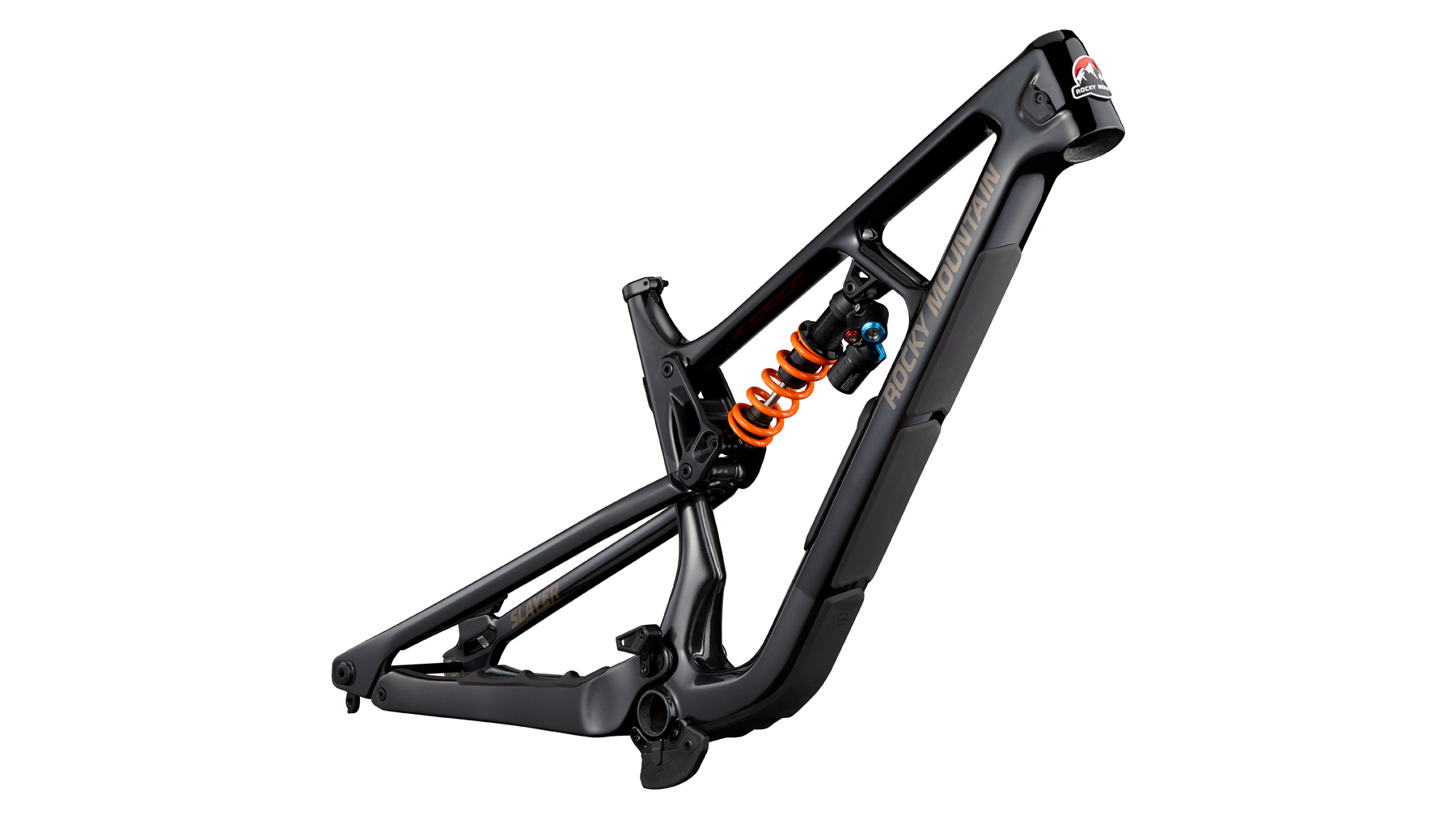
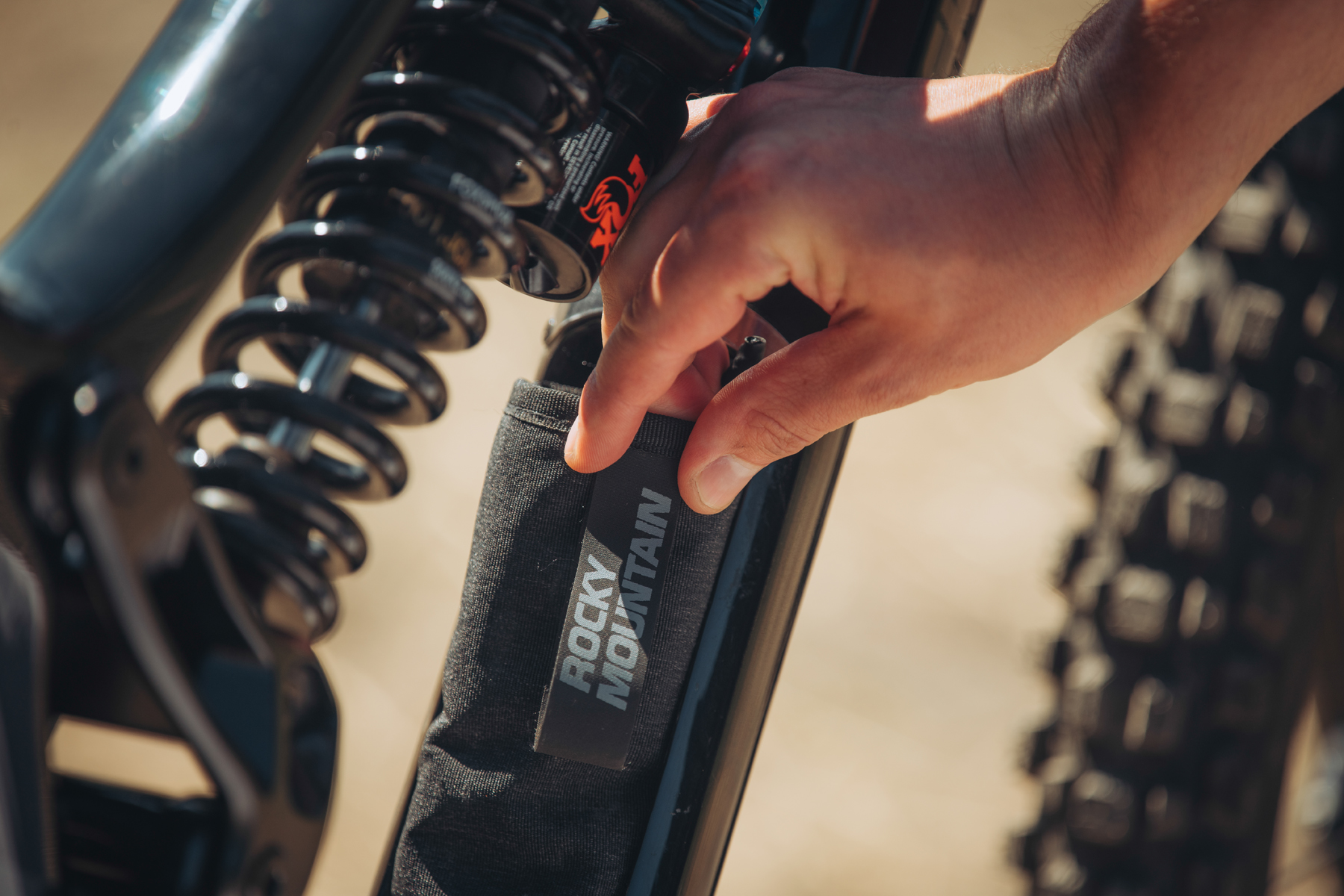
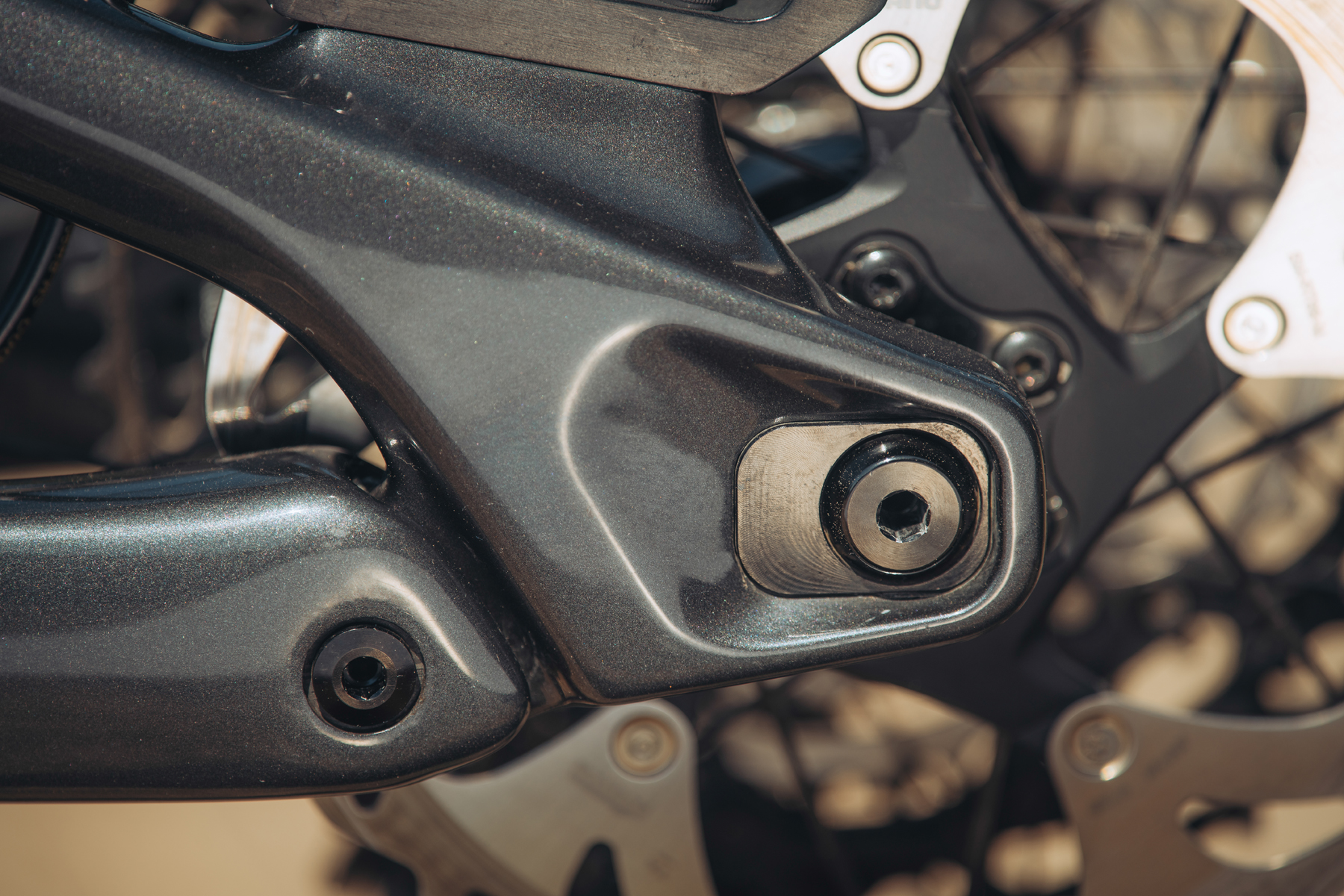
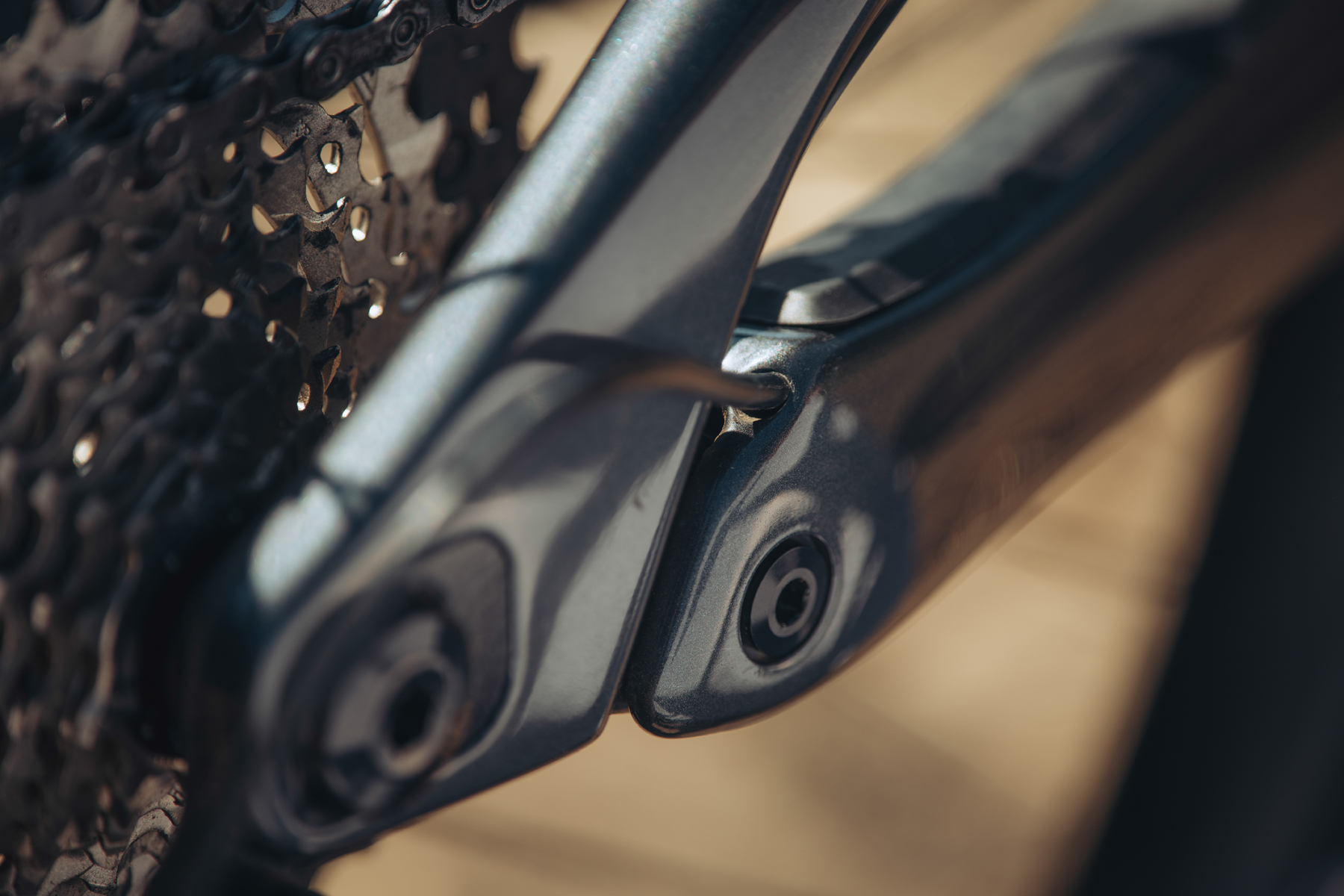
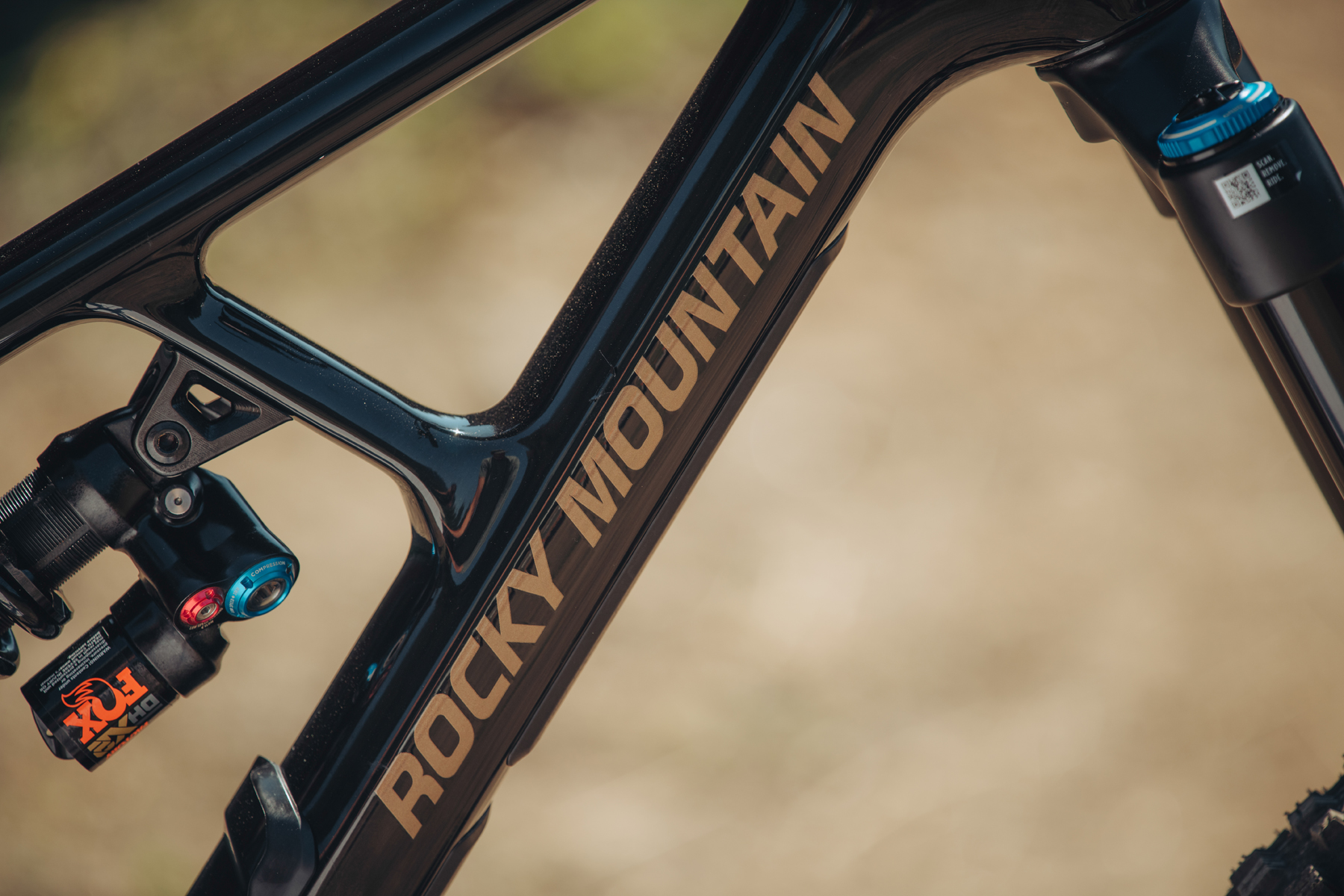
No matter the frame material, you get ample rubber guards on the chainstay, seatstay, and downtube; room for a water bottle inside the front triangle (on all sizes); and the lower two ISCG-05 mounts, plus a built-in OneUp upper chainguide. Cable routing is internal (with provisions for routing the rear brake on either side of the headtube).
Rocky Mountain has also made some tweaks to the suspension kinematics, increasing the anti-squat early in the travel to about 107% (falling off to 75% by bottom out, in a very straight line); the leverage curve is generally similar, with a flat-ish portion at the very top of the travel (at about 3:1 leverage ratio) before falling off to a little under 2.2:1.
[Rocky Mountain publishes their leverage ratio graphs as a ratio of shock movement to wheel movement rather than the other way around; picture the graph flipped upside down to get the more conventional format.]
Most of the Slayer builds come with a 180mm-travel single-crown fork, but the frame is rated for a 200/203mm-travel dual crown as well (which works out to a very similar axle-to-crown height as a 180 mm single crown). And to round things off, Rocky Mountain has refined a bunch of the pivot hardware and other smaller details, including making one Ride-4 chip threaded (so it’s now a single-tool job to swap positions) and revising the pivot hardware for increased stiffness and easier serviceability.
Fit & Geometry
The new Slayer comes in the same four sizes (Small, Medium, Large, XL) as before, but they’ve grown in reach, the headtube has gotten slacker, the chainstays longer, the seat tube steeper, and so on — all the modern trends we’d expect for a burly, long-travel bike.
The “neutral” position on the Slayer’s Ride-4 flip chip now results in a 63° headtube angle and 77.5° (effective) seat tube angle across the size range; the Large frame gets a 480 mm reach (with a 30 mm jump to the Medium and XL frames, and the Small coming in at 430 mm). The significant kink in the seat tube means that the Slayer’s effective top tube numbers aren’t wildly short relative to the reach (621 mm on the Large), but they’re certainly not notable outliers, either.
The other positions on the Ride-4 chip toggle the headtube angle by -0.5° or +0.3° and result in 29 or 19 mm of bottom bracket drop, respectively, (from 22 mm in the neutral setting) along with a few millimeters change in reach. And then irrespective of frame size, the chainstay flip chip produces either 439 or 449 mm chainstay lengths (give or take a millimeter depending on Ride-4 setting).
The Builds
Rocky Mountain offers six different builds for the Slayer, with five getting wide range 12-speed drivetrains and single-crown forks, and the Slayer Alloy 30 Park opting for a dual-crown fork, 7-speed DH drivetrain, and forgoing a dropper post.
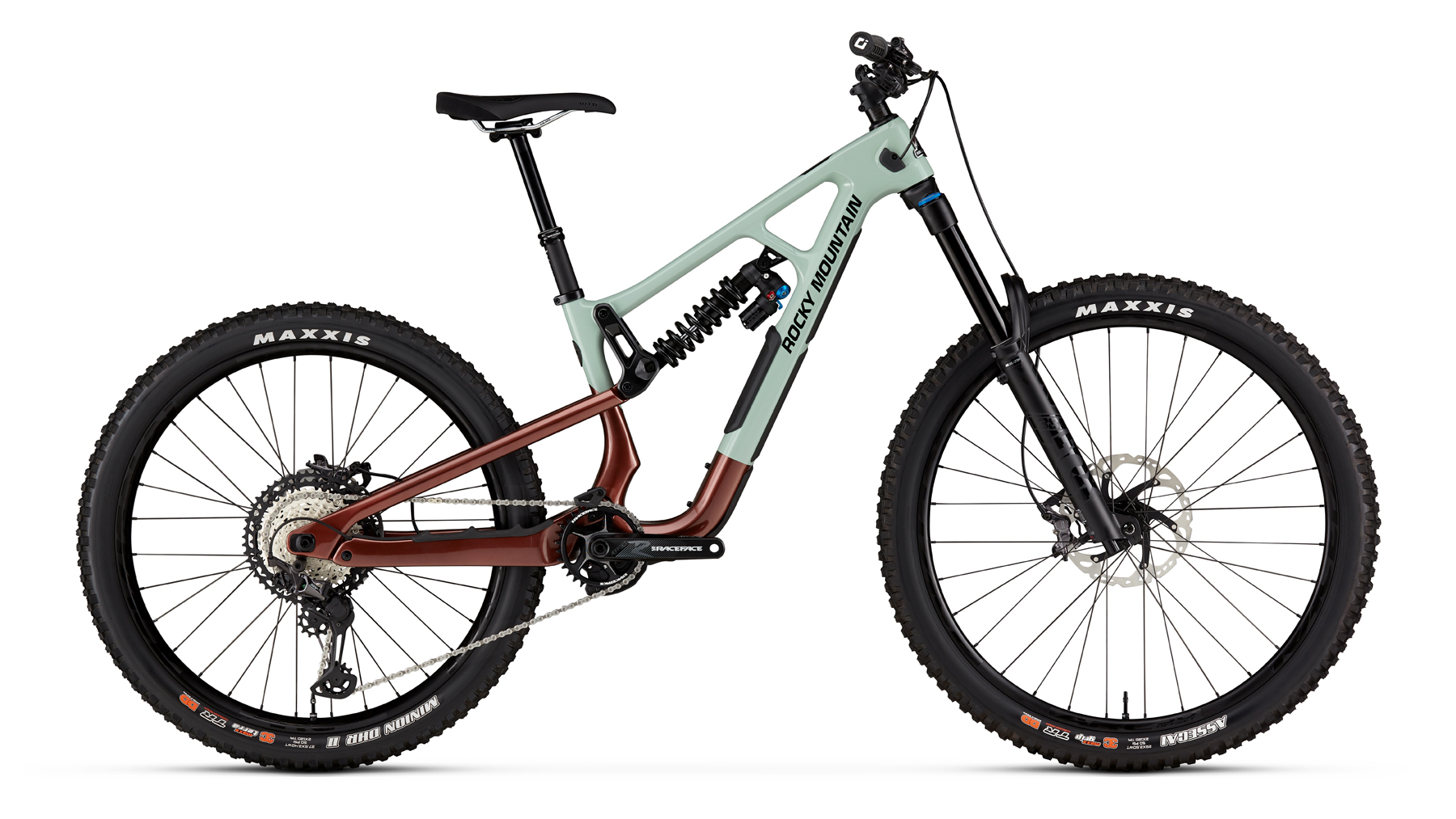
- Drivetrain: Shimano Deore 12-speed
- Brakes: Shimano MT4120 4-piston (w/ 203 mm rotors)
- Fork: RockShox Domain C
- Shock: Marzocchi Bomber CR
- Wheels: WTB ST i30 rims w/ Shimano MT410 hubs
- Dropper Post: Rocky Mountain Toonie (S: 125 mm; M: 150 mm; L & XL: 170 mm)
- Drivetrain: Shimano GX DH
- Brakes: SRAM Guide RE (w/ 220 mm front / 200 mm rear rotors)
- Fork: RockShox Boxxer Select RC
- Shock: RockShox Super Deluxe Coil Select
- Wheels: Race Face ARC 30 HD rims w/ SRAM MTH 746 rear / Rocky Mountain front hubs
- Dropper Post: n/a
- Drivetrain: Shimano SLX w/ XT rear derailleur and Deore cassette
- Brakes: Shimano SLX 4-piston (w/ 203 mm rotors)
- Fork: RockShox ZEB Select RC
- Shock: RockShox Super Deluxe Select+ coil
- Wheels: WTB ST i30 rims w/ DT 370 rear / Rocky Mountain front hubs
- Dropper Post: Race Face Aeffect R (S: 125 mm; M: 150 mm; L & XL: 175 mm)
- Drivetrain: Shimano SLX
- Brakes: Shimano SLX 4-piston (w/ 203 mm rotors)
- Fork: Fox 38 Performance
- Shock: Fox DHX2 Performance Elite
- Wheels: WTB ST i30 rims w/ DT 370 rear / Rocky Mountain front hubs
- Dropper Post: Race Face Aeffect R (S: 125 mm; M: 150 mm; L & XL: 175 mm)
- Drivetrain: Shimano XT
- Brakes: Shimano XT 4-piston (w/ 203 mm rotors)
- Fork: Fox 38 Performance Elite
- Shock: Fox DHX2 Performance Elite
- Wheels: Race Face ARC 30 front / ARC 30 HD rear rims w/ DT 370 rear / Rocky Mountain front hubs
- Dropper Post: Race Face Turbine R (S: 125 mm; M: 150 mm; L: 175 mm; XL: 200 mm)
- Drivetrain: Shimano XTR
- Brakes: Shimano XTR 4-piston (w/ 203 mm rotors)
- Fork: Fox 38 Factory
- Shock: Fox DHX2 Factory
- Wheels: Race Face ARC Carbon rims w/ DT 350 hubs
- Dropper Post: Rox Transfer Factory (S: 125 mm; M: 150 mm; L: 175 mm; XL: 200 mm)
I’ve lost track of how many times I’ve complained about long-travel bikes coming with too light tire casings (usually Maxxis Exo+ ones) and/or hard-rubber front tires, so I’m very pleased to see Rocky Mountain spec’ing a Maxxis Assegai MaxxGrip / Minion DHRII MaxxTerra tire package with DoubleDown casings at both ends across the range, apart from the Slayer 30 Park, which gets a Maxxis Minion DHF / DHRII combo in DH casings with MaxxGrip rubber. And then Rocky Mountain takes things a step further by also including Cush Core XC tire inserts in both tires on all of the Carbon builds. I’m routinely swapping out Exo+ tires for burlier options on Enduro bikes that come through here, either after promptly destroying the lighter-duty casings, or preemptively so that I don’t have to deal with doing so mid-ride. For the intentions of the Slayer, going to at least DoubleDown casings seems like the objectively correct decision. Good job, Rocky.
If I have to nitpick anything (and let’s be honest, it’s my job to nitpick) I’d like to see longer-stroke dropper posts on some of the builds and sizes — I know I’d want a 200 mm one on the size Large frame that I’d ride. But overall, the builds Rocky Mountain has put together look very sensible, and we’re into the fact that Rocky doesn’t seem to be worrying too much about weight — with coil shocks, beefy tires, inserts, and so on — on this sort of bike, and instead just trying to make it ride well and hold up to the terrain and speeds for which it’s intended.
Some Questions / Things We’re Curious About
(1) Just how versatile is the Slayer? Does it feel like a viable option for folks looking to do big days in the saddle while linking together a bunch of burly descents under pedal power, or is it more like a DH bike with a little extra pedalability for the odd short climb? We’re betting on the former, but are excited to get on a Slayer to find out.
(2) And who is going to be best served by a slightly shorter-travel, more compact bike (like Rocky Mountain’s own Altitude) as opposed to the Slayer?
Bottom Line (For Now)
It won’t be the right bike for every rider in every locale, but we’re excited to see an ever-growing number of pedalable long-travel Freeride / Park bikes coming to market, and the new Rocky Mountain Slayer looks like a very promising take on the genre. We should be getting on one later this summer, so stay tuned to hear how we get along with it.

